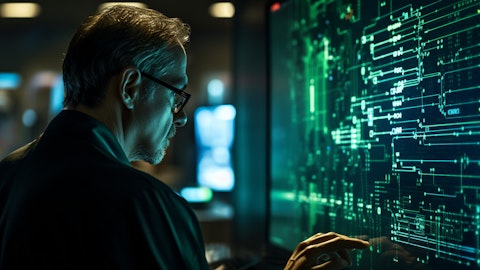The upticks, however, have been modest, and I don’t think reflective of the snapback that I would expect when the broader retail recovery occurs. While some of our partners have signaled expectations of retail recovery in the second half of the year, and as Chris mentioned, some of our green shoots are greener this quarter than they were last quarter. We’re a couple of steps removed away from end customer demand. And I don’t think it’s our place to call the timing of a retail recovery. We’re very encouraged by the progress that we’re seeing in demand and the improvements that we’re seeing. But at this point, I’m not modeling a retail rebound in the first half of the year.
Jim Ricchiuti: Got it. Thank you.
Operator: Thank you. The next question is from Mike Walkley with Canaccord Genuity. Please go ahead.
Unidentified Analyst: Hi. This is Julian Rajan [ph] on for Mike. Thank you for taking the question and congrats on the strong performance. So for Chris, Impinj a strong intellectual property, can you discuss how you are protecting your IP and update us on the status of your ongoing lawsuit with NXP? And also with the potential for a monetary award given your recent wins, how should we think about a potential amount? Or could a royalty type of arrangement happened with NXP? Thank you.
Chris Diorio: Julian, thank you. And the answer to that question could take more time than I think we have here. We’ll say that we have gone through three separate trials with NXP, one in Washington, one in California and one in Texas. And we have prevailed in all three of those trials In addition, NXP suite us in three separate trials in China and subsequently dropped all three of those trials. So I feel good about where we are to date. There have been jury awards, both in terms of damages and lost profits as well as ongoing royalties, but the final judgments haven’t yet been entered by the courts. So it’s a bit — and there are some motions back and forth and a lot of the other things that go on at the legal front. So it’s too early for us to call where we will net out.
As I said in my prepared remarks, prepared to take this litigation through to a successful completion. We feel that we need to defend our leadership position in the market, our intellectual property that we expended so much effort to develop as the market creator against copy our products and infringe our IP. So you should expect us to continue pursuing that litigation. Settlement takes two parties. To date, there hasn’t — we haven’t been able to reach a settlement with NXP. I don’t know if we will or we won’t. Either way, we feel that it’s our obligation to protect our company for tech protect against people who copy it. And so expect us to do our best to going forward, and like I said, pursue this litigation to a successful outcome.
Unidentified Analyst: Thank you.
Chris Diorio: Thank you, Julian.
Operator: Thank you. Your question comes from Chris Kapsch with Loop Capital Markets. Please go ahead.
Chris Kapsch: Hi, good afternoon. My questions are focused around the M800 offering. And so I understand the manufacturing yield benefits that you’ll get with that chip being produced at an advanced technology node, given the much greater die per weight per yield. And I appreciate the gross margin tailwind that you mentioned the 300 bps of upside as that transition happens. I’m just curious if any of that IC unit cost improvement accrues to your inlay customers as well? I’m asking because I was wondering if that would be an incentive for them to ship more of their inlay footprint or production to inlays based on your chips? And then I had a follow-up.
Chris Diorio: Yes, Chris. Got it. Thank you. Good question. So the M800 has roughly 25% greater rebranch than the M700. That’s with the same-size antenna. Or said another way, if you shrink the size of the antenna and save money on the inlay cost, you can get the same effect of rebranches in M700. So our inlay partners have the opportunity to either get that greater range profit for applications that needed or that is often the case, reduce their inlay costs, their antenna costs, their PET costs, other costs and achieve the same performance that they’ve been able to get in the market. So there is definitely an incentive for our inlay partners to move forward with the M800. It’s just overall good news for them, for us, an incredible product, and they will see a benefit from it.
Cary Baker: And then, Chris, this is Cary. I would add that from a pricing perspective, we made the conscious decision to price the M800, even though it is more performant and more manufacturable, slightly below the M700 to accelerate that adoption. As I mentioned earlier, the typical adoption ramp is multiple years. We want to do that much quicker than that. We’ll know more, if we’re successful in accelerating this adoption in another six months, but that is our goal. At this point, I’m not modeling, a visible gross margin impact in the first half of the year and like I said, no more than six months.
Chris Kapsch: Got it. That’s very helpful color. And then separately, you mentioned one feature, the greater read range. And I believe there’s, other features that are imported into the M800 chip design. And just curious if those benefits are in and of themselves enough to – for the market to see impetus to embrace adoption of a program, based on the capabilities of this new product. And just curious, because if that’s the case, it would also be something that helps extend your IP mode, as the industry continues to grow and mature. Thank you.





